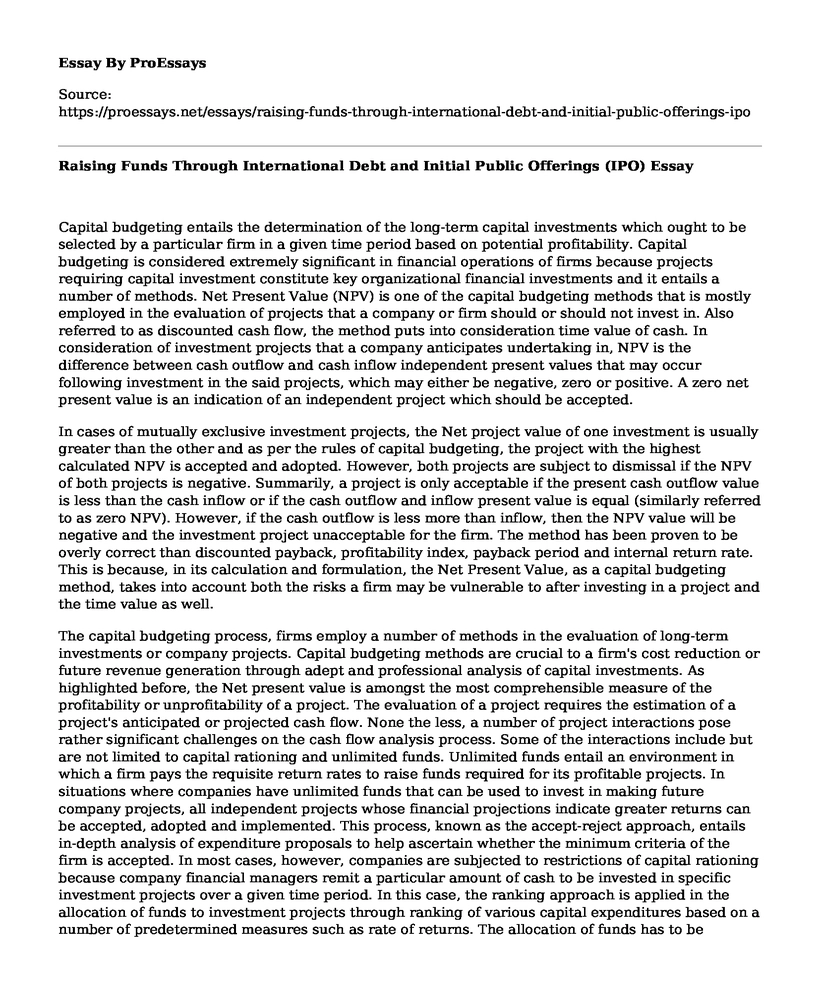Capital budgeting entails the determination of the long-term capital investments which ought to be selected by a particular firm in a given time period based on potential profitability. Capital budgeting is considered extremely significant in financial operations of firms because projects requiring capital investment constitute key organizational financial investments and it entails a number of methods. Net Present Value (NPV) is one of the capital budgeting methods that is mostly employed in the evaluation of projects that a company or firm should or should not invest in. Also referred to as discounted cash flow, the method puts into consideration time value of cash. In consideration of investment projects that a company anticipates undertaking in, NPV is the difference between cash outflow and cash inflow independent present values that may occur following investment in the said projects, which may either be negative, zero or positive. A zero net present value is an indication of an independent project which should be accepted.
In cases of mutually exclusive investment projects, the Net project value of one investment is usually greater than the other and as per the rules of capital budgeting, the project with the highest calculated NPV is accepted and adopted. However, both projects are subject to dismissal if the NPV of both projects is negative. Summarily, a project is only acceptable if the present cash outflow value is less than the cash inflow or if the cash outflow and inflow present value is equal (similarly referred to as zero NPV). However, if the cash outflow is less more than inflow, then the NPV value will be negative and the investment project unacceptable for the firm. The method has been proven to be overly correct than discounted payback, profitability index, payback period and internal return rate. This is because, in its calculation and formulation, the Net Present Value, as a capital budgeting method, takes into account both the risks a firm may be vulnerable to after investing in a project and the time value as well.
The capital budgeting process, firms employ a number of methods in the evaluation of long-term investments or company projects. Capital budgeting methods are crucial to a firm's cost reduction or future revenue generation through adept and professional analysis of capital investments. As highlighted before, the Net present value is amongst the most comprehensible measure of the profitability or unprofitability of a project. The evaluation of a project requires the estimation of a project's anticipated or projected cash flow. None the less, a number of project interactions pose rather significant challenges on the cash flow analysis process. Some of the interactions include but are not limited to capital rationing and unlimited funds. Unlimited funds entail an environment in which a firm pays the requisite return rates to raise funds required for its profitable projects. In situations where companies have unlimited funds that can be used to invest in making future company projects, all independent projects whose financial projections indicate greater returns can be accepted, adopted and implemented. This process, known as the accept-reject approach, entails in-depth analysis of expenditure proposals to help ascertain whether the minimum criteria of the firm is accepted. In most cases, however, companies are subjected to restrictions of capital rationing because company financial managers remit a particular amount of cash to be invested in specific investment projects over a given time period. In this case, the ranking approach is applied in the allocation of funds to investment projects through ranking of various capital expenditures based on a number of predetermined measures such as rate of returns. The allocation of funds has to be implemented to ensure the funding constraints are curtailed through the achievement of maximum shareholder value.
References
Khan, A. (2008). Capital budgeting under capital rationing: an analytical overview of optimization models for government. Intl Journal of Public Administration, 31(2), 168-194.
Khan, M. Y., & Jain, P. K. (2004). Financial management. New Delhi: Tata McGraw-Hill.
Cite this page
Raising Funds Through International Debt and Initial Public Offerings (IPO). (2022, Jun 27). Retrieved from https://proessays.net/essays/raising-funds-through-international-debt-and-initial-public-offerings-ipo
If you are the original author of this essay and no longer wish to have it published on the ProEssays website, please click below to request its removal:
- Impact of Tax on the Market Essay
- The Portman Hotel Company - Evaluation Essay
- Comparing the Compensation of CEOs in Japan and USA Essay
- Leadership Through Innovation Paper Example
- Innovation and Entrepreneurship by Drucker Book Review
- Essay Example on FCPA of 1977: Prohibiting Bribery Among Individuals & Companies
- Essay Example on Comparing Apollo Global & American Financial Group: Key Insights for Investors







